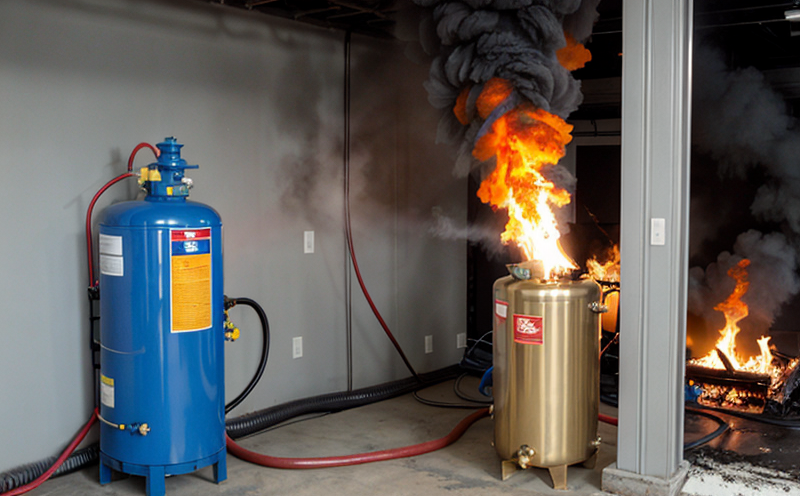Fire Suppression System Leakage and Seal Testing
In today's increasingly stringent fire safety requirements, ensuring that fire suppression systems are both effective and reliable is paramount. Fire suppression system leakage and seal testing is a critical component of this assurance process, designed to identify potential vulnerabilities in the integrity of the system’s components such as nozzles, pipes, and valves. This service ensures that these components remain intact under operational conditions, thereby minimizing the risk of accidental release or failure which could compromise fire safety.
The testing procedure involves subjecting the system to pressure or fluid challenges, simulating real-world operating conditions. By doing so, we can detect any minute leaks or seals failures that may have gone unnoticed during installation or maintenance. This is especially crucial in sectors such as commercial buildings, manufacturing plants, and public infrastructure where fire safety compliance is non-negotiable.
The testing process typically begins with a thorough inspection of the system to ensure all components are properly installed and connected. Next, pressure is applied to each section of the system while closely monitoring for any signs of leakage or failure in seals. This step is critical as it not only identifies current issues but also provides insights into potential future problems, allowing for proactive maintenance.
For accurate testing, specialized equipment such as pressure gauges and leak detectors are used to measure precise levels of pressure and detect even the smallest leaks. The results of these tests are meticulously recorded and analyzed, providing a comprehensive report that outlines any deficiencies found in the system. This information is invaluable for quality managers, compliance officers, and R&D engineers who rely on such data to make informed decisions regarding maintenance schedules and upgrades.
By leveraging advanced testing methodologies, we can ensure the highest standards of safety and reliability within your fire suppression systems. Our expertise extends beyond mere testing; it includes a deep understanding of applicable international standards like ISO 17629 for water-based fire suppression systems, ensuring that our methods are aligned with global best practices.
The importance of this service cannot be overstated. In the event of an actual fire emergency, a leak or failed seal could mean the difference between containing the blaze and facing catastrophic consequences. Our rigorous testing process helps prevent such scenarios by identifying and addressing potential issues before they become critical problems.
Why It Matters
The integrity of fire suppression systems is not just a technical requirement; it's a safety imperative. In environments where fires can rapidly escalate, even the smallest leak or seal failure can lead to severe consequences. By conducting regular leakage and seal tests, we ensure that every component of your system functions as intended.
From an operational perspective, these tests provide crucial insights into the health and longevity of your fire suppression systems. Identifying leaks early allows for timely repairs, thus avoiding costly replacements later on. Furthermore, compliance with stringent standards like ISO 17629 ensures that you meet regulatory requirements, mitigating the risk of legal penalties and reputational damage.
For quality managers and R&D engineers, these tests offer valuable data points that can drive continuous improvement efforts. By understanding where specific components perform well or underperform, improvements can be made to enhance overall system reliability. This proactive approach not only enhances safety but also contributes positively to the bottom line through reduced maintenance costs and improved operational efficiency.
The importance of this service extends beyond individual facilities; it plays a vital role in safeguarding entire communities. In public infrastructure like airports, hospitals, and government buildings, any failure in fire suppression systems could have far-reaching implications. Ensuring that these systems are robust and dependable is essential for protecting lives, property, and critical operations.
Applied Standards
The testing of fire suppression system leakage and seals adheres to a number of international standards designed to ensure the highest level of safety and reliability. Among these are:
- ISO 17629: Water-based fire extinguishing systems – Acceptance test
- ASTM E1523: Standard Practice for Leak Testing of Fire Protection Systems
- EN 334: Requirements for sprinkler systems and their components
These standards provide detailed protocols that guide the testing process, ensuring consistency across different facilities and jurisdictions. Compliance with these standards not only demonstrates commitment to safety but also facilitates smoother interactions with regulatory bodies.
Competitive Advantage and Market Impact
In an industry where compliance and reliability are key factors in maintaining competitive advantage, our fire suppression system leakage and seal testing service offers several distinct benefits:
- Enhanced Safety Reputation: Demonstrating adherence to stringent international standards enhances your reputation as a leader in safety and quality.
- Cost Savings Through Prevention: Early identification of issues through regular testing reduces the need for costly emergency repairs or replacements.
- Regulatory Compliance: Ensuring compliance with relevant regulations helps avoid potential legal issues and penalties, safeguarding your business interests.
- Informed Decision-Making: Providing comprehensive test results and analysis gives you the data needed to make informed decisions about maintenance schedules and system upgrades.
By integrating our services into your operational strategy, you not only meet current regulatory requirements but also position yourself ahead of competitors by prioritizing safety and reliability. This proactive approach can significantly impact market perception and drive long-term business success.





